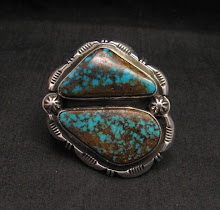 Follow these tips to keep your Native American jewelry in excellent condition and looking its best for years!
Follow these tips to keep your Native American jewelry in excellent condition and looking its best for years!
CARE OF STERLING SILVER JEWELRY
Sterling Silver is actually somewhat soft and easily scratched if mishandled. One of the best and simplest way to care for sterling silver jewelry is to use silver polishing cloths that have been specially designed and treated for the purpose of cleaning sterling silver jewelry. These cloths are made of a felt-like material and are impregnated with special non-scratch micro-abrasives. You just rub the surface to be polished with medium pressure to remove tarnish and even light surface scratches. We recommend a cloth like the Sunshine Polishing Cloth, which we sell on our website.
We usually recommend that silver cleaning solutions, cleaners or creams not be used to clean Native American silver jewelry. Many pieces are set with stonework, and if the solutions are used, the stones can be damaged or the color of the stones may change. Many pieces are made with a technique in which the piece was intentionally blackened in strategic areas of the jewelry to provide design definition. Creams can settle in creases of jewelry and can not be removed without damage to the piece.
Special care should also be used when cleaning Hopi jewelry. DO NOT dip Hopi jewelry in any type of liquid silver polishing cleaner, nor should you use any other type of chemical silver polishing cleaner or solution because you will ruin the dark recessed oxidized areas. And hence the contrast of the design and the essence of Hopi jewelry will be lost. Use only a silver polishing cloth like the ones we sell and AVOID rubbing the dark recessed oxidized areas. Keeping your sterling silver in the open air for extended periods of time without wearing it may cause it to tarnish. To prevent silver from tarnishing, place jewelry in a sealable plastic bag; for added protection, include an anti-tarnish strip. An important exception to this rule relates to jewelry that has been intentionally oxidized or antiqued, as part of the design. This type of jewelry should not be stored in airtight plastic bags, so simply punch a hole in the plastic bag.
CARE OF TURQUOISE JEWELRY
Turquoise is a beautiful stone that is porous so use caution when caring for and cleaning turquoise jewelry. Protect turquoise from prolonged sun exposure, extreme temperatures, cosmetics, perfumes, skin oils, grease, or any other harsh chemicals, as they might discolor the stone. When cleaning turquoise jewelry, use a very soft brush or a slightly damp soft cloth. Do not submerge turquoise in water and avoid using commercial jewelry cleaners, ultrasonic cleaners, chemicals or even soap. A polishing cloth is another safe way to clean or polish turquoise.
Remove jewelry before performing gardening, household tasks or any strenuous activity. Dirt can get into stone settings and scratching of surfaces is possible.
CARE OF INLAY JEWELRY
Remember to treat the inlay jewelry with extra care. Avoid dropping, banging or scratching inlay jewelry. Do not wash with soap and water. And, again, avoid using commercial jewelry cleaners, ultrasonic cleaners or chemicals to clean inlay jewelry. Instead, use polishing cloths to shine or clean inlay jewelry.
Do not attempt to reshape or bend a bracelet, necklace, ring or pendant with inlay or channel work. Do not re-size rings with channel or inlay work. Changing the shape of the underlying metal can loosen the stones. They can actually pop out while the item is being bent and/or the integrity of the setting can be compromised, so that the stones may fall out later on, without being noticed.









No comments:
Post a Comment